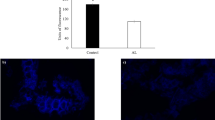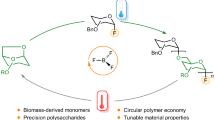Abstract
IDENTIFICATION of oligosaccharide intermediates liberated during the enzymatic hydrolysis of a polysaccharide provides information on both the structure and mode of hydrolysis of the polymer. Isolation of these intermediates in good yield is facilitated if they can be removed from the enzyme site before further hydrolysis occurs. Perila and Bishop1 accomplished this removal by hydrolysing a glucomannan in a dialysis sac to give a good yield of disaccharides (28 per cent) and lesser yields of tri- and tetra-saccharides (8 per cent each), and Timell2 likewise hydrolysed a glucuronoxylan to moderate yields of oligosaccharides (none of these authors specified the grade of dialysis tubing used). Similarly, with a protozoal xylanase, we found that a convincing demonstration of the liberation of xylodextrins of a degree of polymerization (DP) > 3 was only obtained when the xylan was hydrolysed by the enzyme with concurrent dialysis in 20/32 ‘Visking’ tubing (Union Carbide Corp, N.Y.). Oligosaccharides of DP 3–5 are of relatively low molecular weight, but in our experience they dialysed at far slower rates than those reported for comparable peptides (see Table 2, Craig and King3). The dialysis of various oligosaccharides was therefore investigated in a simple dialysis chamber consisting of a piece of glass tubing (7 × 3.5 cm diam.) closed at one end with a sheet of opened-out dialysis tubing. The closed end dipped just below the external solution (10 ml.), the oligosaccharide solution (10 mg in 2 ml.; 3.3 cm2 of membrane per ml.) was placed inside the chamber and both solutions were gently stirred with magnetic stirrers. At intervals, portions (100 µl.) of external solution were removed for the measurement of dialysed oligosaccharide so that the time for the diffusion of half the initial oligosaccharide (half-escape time) could be calculated. Three grades of ‘Visking’ seamless cellulose tubing were used; 20/32, 36/36 and C-75 heavy wall.
This is a preview of subscription content, access via your institution
Access options
Subscribe to this journal
Receive 51 print issues and online access
$199.00 per year
only $3.90 per issue
Buy this article
- Purchase on SpringerLink
- Instant access to full article PDF
Prices may be subject to local taxes which are calculated during checkout
Similar content being viewed by others
References
Perila, O., and Bishop, C. T., Canad. J. Chem., 39, 815 (1961).
Timell, T. E., Chem. Indust., 999 (1959).
Graig, L. C., and King, J. P., Methods in Biochem. Anal., 10, 175 (1962).
Author information
Authors and Affiliations
Rights and permissions
About this article
Cite this article
BAILEY, R., GAILLARD, B. Dialysis of Oligosaccharides. Nature 207, 292 (1965). https://doi.org/10.1038/207292a0
Issue date:
DOI: https://doi.org/10.1038/207292a0



